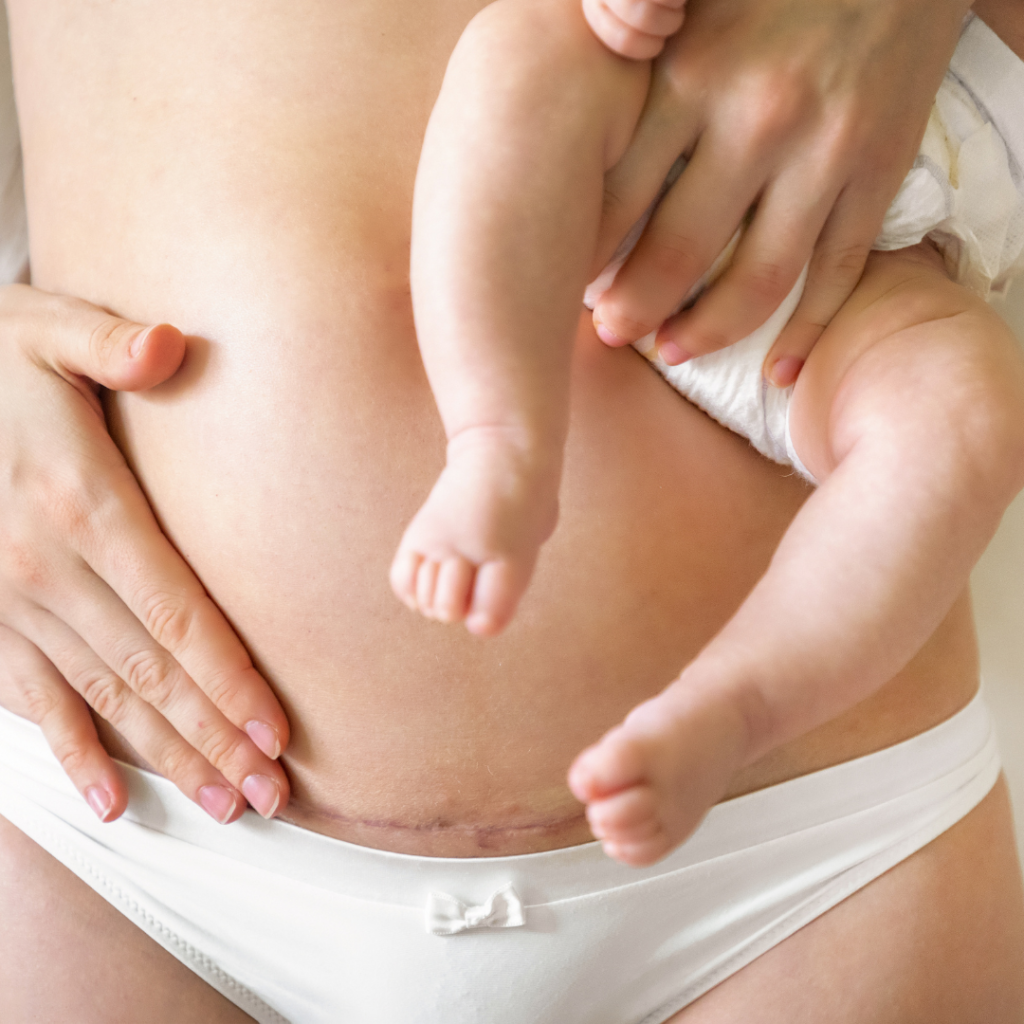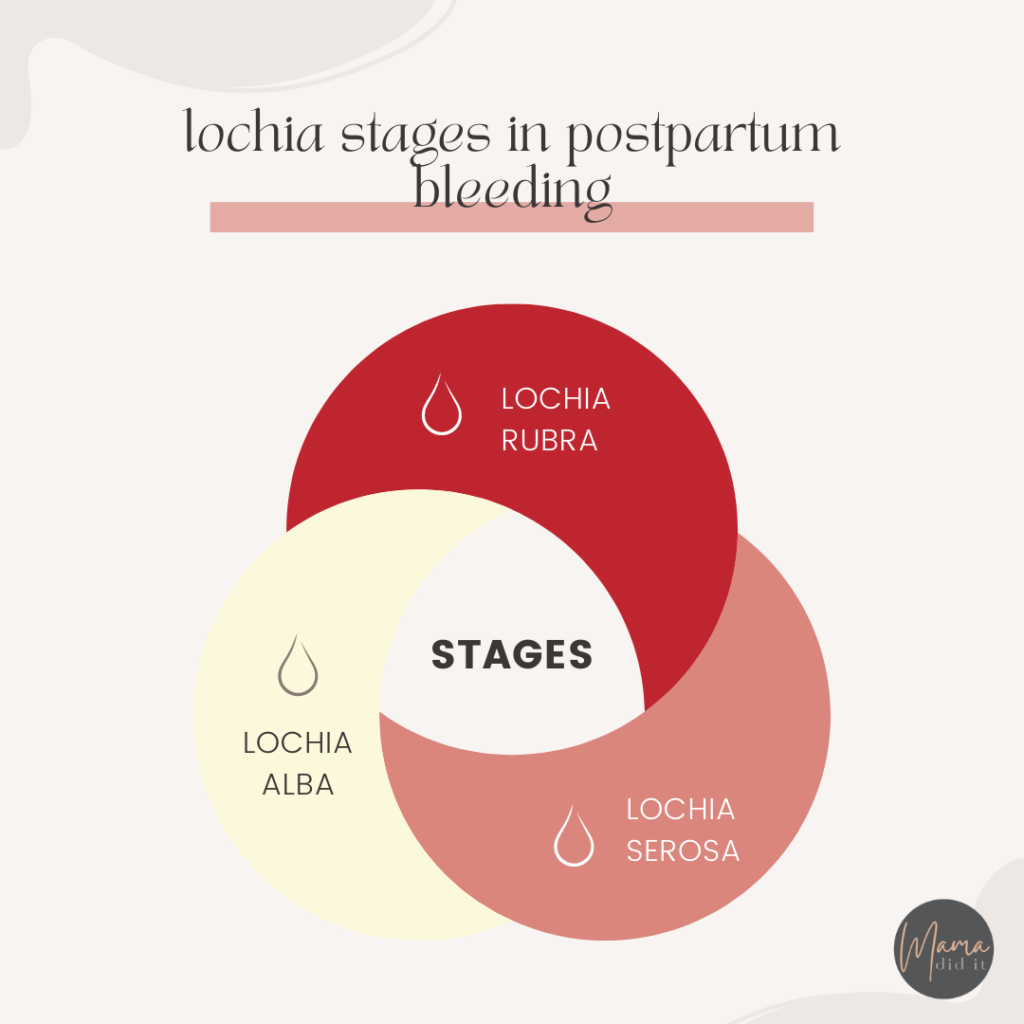Postpartum Bleeding and what you can expect after birth. Plus, how to tell if it is postpartum hemorrhage.
Postpartum vaginal bleeding is normal after vaginal birth and a cesarean section. But what exactly is normal postpartum bleeding, why does it happen, how long does it last, and how do you know if it’s possibly postpartum hemorrhage? And what if I’m having bright red bleeding at six weeks?
As a postpartum nurse and mother of 3, I’m here to answer all of these questions and more!
Why do we bleed after birth?
After we give birth to our baby, we then give birth to our placenta. This leaves a wound that begins to close and heal. We also begin to shed the thick lining of the uterus from pregnancy. This initial bleeding, though it can resemble a heavy period, is called lochia. Uterine contractions help push this blood out and begin the process of shrinking our uterus back down to its normal size.

What to Expect After Birth: Postpartum Bleeding
You will bleed heavily, similar to a heavy period the first several days following birth. You may pass small, quarter-size blood clots at times, especially if you have been in the bed for several hours and then get up. If you are ever concerned about your bleeding, be sure and let your nurse know. Your bleeding will get lighter and taper off a little more each day. See the different stages of lochia, postpartum vaginal discharge, below.
Cause of Bleeding after Birth
Lochia, after birth vaginal discharge, comes in three forms: lochia rubra, lochia serosa, and lochia alba. Typically, you will experience heavy bleeding the first few days after both vaginal delivery and cesarean delivery. This is a great time to use the large maternity pads your birthing center or hospital provides. Some women prefer disposable underwear as opposed to large underwear plus a large pad. Disposable underwear may also help protect clothes more from possible leakage. Once you are discharged home, you can use regular menstrual pads (though an overnight sanitary pad may be the best choice for a week or so).
This bloody discharge will begin to get lighter and taper off as the days go by. Postpartum Bleeding can last up to six weeks. If you have a cesarean birth, you usually experience less lochia. Many c-section patients only experience vaginal bleeding for the first two to three weeks in their postpartum recovery.
Lochia Stages
Lochia Rubra is bright red blood. Pink-tinged or brownish bleeding is called lochia serosa. White to yellowish discharge is lochia alba.

Bright red bleeding at six weeks postpartum
This can be normal. Postpartum bleeding can last up to six weeks. If you are breastfeeding, this is probably still lochia bleeding. You may notice bright red bleeding at 6 weeks (even if the lochia had already begun to change colors) if you have been too active and are pushing your body too hard. Listen to your body. Rest when it tells you to.
If you are formula feeding, bright red bleeding could be the return of your first postpartum period. See below for what to expect with your first period and to make sure it isn’t symptoms of postpartum hemorrhage.
Common Cause of Postpartum Hemorrhage: Risk Factors
- uterine atony
- placental abruption
- high blood pressure
- retained placental tissue
- giving birth to a large baby
- giving birth to multiples
- having given birth several times
Uterine atony, a boggy uterus, can hinder the contraction process, cause excessive bleeding, and put new moms at greater risk for postpartum hemorrhage. Uterine massage is a great exercise to prevent this from happening. Learn the Art of Uterine Massage from a pro!
Symptoms of Postpartum Hemorrhage: When you need medical attention
There are several signs that you should call your doctor with postpartum bleeding. Some of these are passing golf ball size large clots, soaking a pad in one hour, weakness, dizziness, or passing out. Also, watch for rapid heart rate and other signs of infection.
Call your healthcare provider, or 911 right away if you are experiencing any of these symptoms. Your healthcare provider will do a vaginal exam, administer medications to minimize blood loss, and may administer a blood transfusion if your red blood cells are too low.

It is recommended by your health care provider that you don’t put anything in the vagina for the first six weeks following childbirth. This means avoiding sexual intercourse, and also includes tampons, douching, and menstrual cups. These can lead to a higher risk of infection. Only use sanitary pads for vaginal bleeding during this time. Here are more causes of postpartum hemorrhage and how we treat it.
The First Postpartum Period: Can I get pregnant before my first period?
The first time we have a menstrual period again varies from woman to woman. Breastfeeding can prolong the first period from returning. Keep in mind that breastfeeding does not prevent pregnancy! This is not a form of birth control. At some point, a mother will ovulate without knowing it and can get pregnant before she has her first period.
If formula feeding, a mother usually begins her period six to eight weeks postpartum. If exclusively breastfeeding, a mother may not have a period the entire time she nurses. I exclusively breastfed my third baby and my first period returned at the one-year mark.
You may experience heavy bleeding and uncomfortable cramping with the return of your first period. (Welcome back, right?) Hot packs and ibuprofen can relieve this pain. Ibuprofen is safe to take while breastfeeding. The first period may last a day or two longer than the periods you are used to as your body adjusts to postpartum life. If you are experiencing golf ball size clots, soaking a pad in one hour, or any of the postpartum hemorrhage symptoms listed above, please call your doctor right away.
4 Weeks Postpartum Bleeding
Postpartum bleeding can last up to six weeks after the birth of your baby. Even if it stops, you may notice it start back a day later. Listen to your body. Increased bleeding when it has already begun to taper off can indicate that you are being too active. Rest when you feel you should. Check the signs and symptoms list above to make sure you are not experiencing postpartum hemorrhage.
You may also like How do I take care of my perineum after birth? and How long is the fourth trimester?
Post may contain affiliate links.

